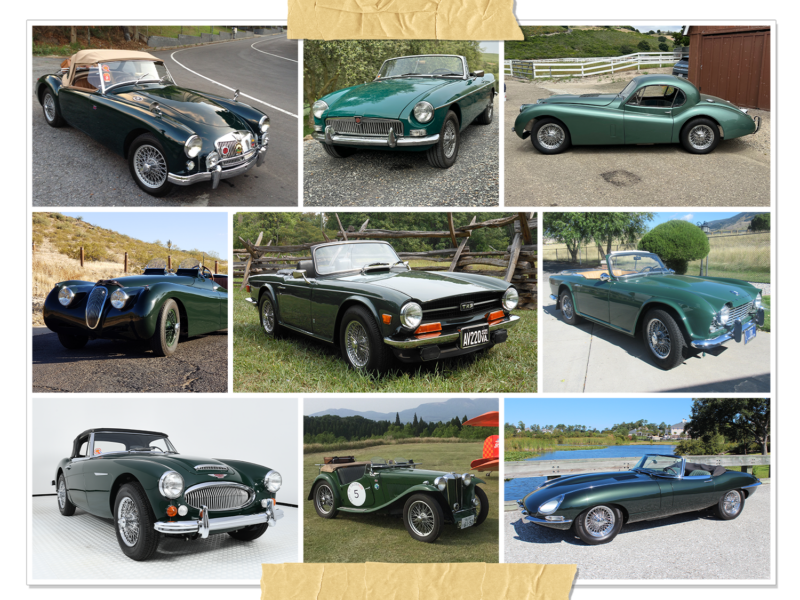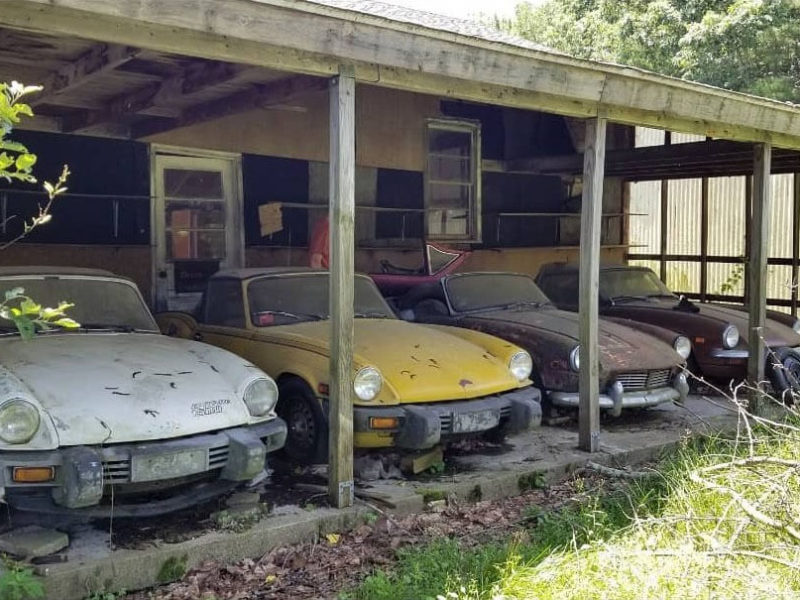We recently received an interesting letter from Phil Smith of Upper Sandusky, Ohio, who last year completed a five week, 10,000 mile camping trip to the west coast and back, accompanied by his wife. Coincidentally I, accompanied by my wife, recently transferred out to our California Corporate Headquarters and made the 3,200 mile journey from Connecticut in five days. We’ve also covered some 20,000 miles each year in the USA and Europe for the past 10 years. “So what?” we hear some of you ask. Both of these long, long journeys were accomplished in what some might term Britain’s most popular small sports car—the classic MGB! However, the purpose of this feature is not to start a discussion on the merits of the MGB vs. other fine cars, but to pass on to you some of the helpful hints and wrinkles that the Smith’s, both Phil and Ken, discovered, for those others of you contemplating a longer journey than the usual Saturday jaunt. Listen in on Phil and Ken as they discuss their findings on getting a “quart into a pint pot’ and staying out of trouble.
Phil: First of all make sure the car is properly serviced with “new” everything in terms of plugs, points, oil, etc. The basics are covered in several books; we found Lindsay Porters’s book, MGB Guide to Purchase and D.I.Y. Restoration to be quite useful, both in terms of readying the car and for a listing of parts and tools that are helpful. We carry a Haynes Manual as well.
Ken: I agree 100% Phil, and what I’ve done is to extract the key bits of information, such as timing details plug gaps, etc., and have them handy in the glove box. For example, carrying all the extras and being fully loaded. I keep my tire pressures at 28psi front and 32psi rear for high speed long distance travel.
Phil: I think we’d both agree that in the “B” storage space is at a premium. We made a vinyl roll bag to carry our tent and bed roll on the luggage rack. We also made extra space by changing the two 6 volt batteries to a single 12 volt, and utilizing the battery box, lined with thin aluminum for extra “not needed on voyage” storage! Weather sealed with strip caulking, this space proved ideal to store our extra distributor, fuel pump and hoses. For our tools, we made canvas roll-up bags then stored these in the space between the rear wheel wells and the fenders.
Ken: Now, while I agree with you on some of the tools, Phil, we tend to go in a rather different direction. I assume from what you say that your spare wheel still resides on the floor on the trunk? Well, ours travels on the luggage rack! We invert the wheel, so the outside laces the trunk lid. suitably protect the luggage rack to avoid scratches, and then in the well of the spare we put all the emergency goodies we might need at the roadside. In here is a spare fan belt, points, plugs and wheel wrench. This avoids having to get everything out of the trunk in an emergency and allows you to make room in the trunk for a decent sized suitcase or tent. The wheel is held onto the luggage rack with strong bunjy cords (the more the merrier) and the assembly is topped off by covering the wheel with a spare vinyl elasticized wheel cover, so no prying eyes can see the bits hidden inside the wheel. If you are still determined to carry your suitcase on the luggage rack, be sure to wrap the case in strong plastic hags. I remember British Leyland used to market a suitcase cover complete with zipper, for just such a purpose. (If you ever see one at a flea market, snap it up!) All this is to protect your case from the elements, including torrential rain. I would prefer to carry the spare wheel on the luggage rack as opposed to the suitcase, as the reduced height of the wheel gives better rear view visibility on the interstate!
Phil: Very interesting, but I guess it’s a matter of personal choice, and we are assuming that every long distance MGB has a luggage rack! But back to the space problem. In the past, I’ve utilized the inside of the front fenders by removing the crescent shaped splash plate inside the wheel arch, and stowing extra anti-freeze and water in suitable containers (on top of the sill), just inside the front fenders. It really is amazing what you can get into those corners of the trunk, but beware! We found out the hard way in Klamath Falls, Oregon that you must be careful around the areas of the wiring harness in the trunk! A piece of our luggage wore through the insulation on the tail light wire, leading to a short circuit and destruction of the rear wiring harness. Fortunately, the main harness didn’t suffer terminal damage. Two or three hours with a pocket knife, 16 gauge wire and lots of electrician’s tape got us on the road again.
Ken: I couldn’t agree more, watch those wires! I feel there are three main areas to consider when packing the MGB. First, behind the seats and on the battery shelf. Second, the space you’ve just mentioned, the trunk, and thirdly, the use of a luggage rack. Most of us drive with the top down during the summer, so insure the top folds properly, and takes up the minimum amount of space as it was designed to do! In this space left after the top is down, go two large “squashy” sports bags, and these contain our overnight gear. If you have to make a motel stop, these are the only two bags you need from the car, every thing in and on the trunk stays undisturbed. Under the top you will find you can also stow several small items behind the bags, such as vanity cases, make-up bags, cameras etc. Make sure that if inertia reel seat belts are fitted, they still come out and retract once all this stuff is in the car. Place a large towel over the exposed part of the top before you fit the hood cover or tonneau. This will save the plastic window of the top from getting scratched. We prefer to use the tonneau cover when on the move, then when we pit stop, we can just throw the top over the seats to cover things from prying eyes!
Phil: Sounds good to me, and I think a note on safety might not come amiss here. For instance a master on/off switch makes good sense, as well as being a theft deterrent.
Ken: I feel that sentiment from the heart!” (Remembering the “B” that disappeared in San Antonio!)
Phil: …and we also fitted our MGB roadster with a Moss roll-bar, just in case! In addition, we increased our visibility to other drivers by putting some reflective scotch tape around the rear of the car. It might just give you that extra second at the road side in the dark to get out of the way!
Ken: Anything that assists the MG Slogan “Safety Fast” is an excellent idea. For instance, in Europe it is illegal to undertake a journey without carrying a reflective rear triangle. If you come to a stop on, say the German Autobahn, you must place it 150 meters behind the stricken vehicle, facing traffic! Even though it may not be a law here, it’s a good idea and stows down the side of the wheel arch well in the trunk. There are several smaller spaces that can be used to carry safety equipment, as it is not the slightest bit of use burying the fire extinguisher or first aid kit in the trunk! They must be immediately at hand with the fire extinguisher under either seat! Don’t forget that the later “B”s came with a map pocket in the passenger foot, well above the inner sill. Why not fit one or two for maps, torch, spark plug wrench, and any bits and pieces. Installation of “seat savers” serves two purposes: it gives you four extra big pockets per car and stops you burning your buns on seats exposed to the hot sun. Buy a smaller cooler, one that fits in the passenger footwell without restriction, and five or six cans of soda will be close at hand. Cover the cooler with a towel and your passenger has a lovely footrest. Again speaking of towels, take plenty, small and large, just for mopping up! Not only rain (which will always get in your MGB!) but also for perspiration, leaks and soda spillages. Towels are one of the best things ever invented for an English sports car owner! Again, on some of the earlier de-smogged cars there are little areas under the hood where items that are unaffected by the heat can be carried, like spare plugs and points. Be sure to wrap them in aluminum foil and secure them with cable ties if necessary. When you pack the trunk, make sure all the “squashy” (there’s that word again) items go over the wheel arches. Several pairs of shoes in plastic bags will fit up here, as well as small water carriers and spare oil. It’s amazing just how much room there is if you pack properly; and remember, large and flat items should go in first, followed by small and flat items and emergency clothing.
Phil: Well, it’s been interesting to compare notes and I hope we meet on the road on some long distance trip in our MGBs!
Ken: Phil, we at Moss thank you very much for your input and we’d like you to accept this Moss gilt certificate with our compliments. We look forward to meeting you and your wife on the great American road.
By Ken Smith







'You Can Do It In An MGB Across Country!' has no comments
Be the first to comment this post!